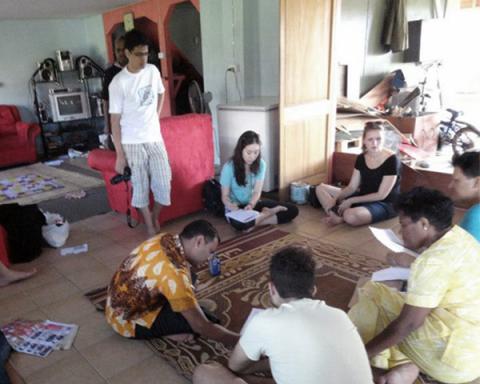Workshop Type:
- Special Workshops & Events
City:
Country:
Year:

A Workshop exploring incremental housing stratergies for the city of Suva
January 7-19, 2013
SCHOOL OF ARCHITECTURE AND PLANNING, MIT, SIGUS - Special Interest Group in Urban Settlement - MIT in collaboration withFiji Department of Housing
Incremental housing is the newly embraced proactive strategy of the global development community. The workshop developed context specific guidelines of incremental housing and site planning for Fiji's new Strategic Housing Policy. The strategy developed would serve as a model for new proactive strategies globally.
The MIT team joined with the planning staff from the Fiji Department of Housing. Teams undertook Field surveys, typologies of current housing and practices, and meetings with communities that will inform the policy recommendations.
Team members from MIT were Aditya Barve, Chris Malcolm, Clay Anderson, Phebe Dudek, and Ana Cristina Vargas Salas from the Department of Architecture, with Jung Hwa Kim and Kelly Heber from the Department of Urban Studies and Planning.
Fiji's housing and urban development ministry is responsible for the planning and implementing the projects that deal with all the squatter settlements in Suva. Research team visited the projects by ministry and other NGO's and interacted with the stakeholder. The projects can be broadly categorized in three categories: Relocation, upgrading and transformation.
Relocation
As suva witnesses rural to urban migration, government tries to relocate the new migrants either to new sites within the city or back in the agricultural villages. Thus the nature of relocation strategy differs as per its context. For urban relocation, government has established Public Rental Board in 1989. It is responsible for construction and renting of housing units to slum dwellers. The amount of rent depends upon the income of the family. most of the families that were relocated in these units are living there for over 20 years. On the other hand, Rural relocation policy is in its initial phase. It is collaboration between ministry of agriculture and department of Housing and Urban Development. In this scheme slum dwellers who volunteer for relocation are given land on a training camp site and are trained in agricultural techniques by ministry. Once they are trained then a new village is formed with land leased by government. Generally the crops are either cash crops like ginger, or fruit produce.
Upgrading
Slum upgrading was another strategy that was undertaken by ministry of housing. It was limited to providing the basic site and services and demarcation of land. This scheme was employed in more established and old slums like Omkar or Bangaladesh. This also includes the regularization of plot lines and relocation of houses that are too dense or obstructing the service lines. Government provided external toilets that linked to the main sewer.
Transformation
Incremental initiatives on their own by people were considered in this category. It was observed that where there is possibility to expand the house it was exploited. This was explicitly seen in the case of Milverton road housing project. This housing was build by public rental board(?) in late 19060's. due the nature of construction and design it lent itself fairly well to incremental growth over time. Some of the houses expanded almost four times of their existing area. Being a row house typology it also exhibited an spontaneous community agreement and control over how and where to expand and even the aesthetics of that expansion.
REFLECTIONS
1 | PARALLELS FROM LATIN AMERICA
Ana Cristina Vargas Salas
This study will focuses on revisiting recent projects in Latin America, which can be clearly related to the informal settlements and housing projects in Fiji. Chile, Colombia and Venezuela will be highlighted as examples of key successful strategies that have been implemented in South America.
See: Parallels from Latin America
2 | REFLECTIONS, PERCEPTIONS, AND "APP"-LICATIONS
Chris Malcolm
Around the world, People build for themselves and 60% of homes in developing countries are being done this way—without professionals. Why not continue to improve by making expertise knowledge available in the form of open-source scalable and accessible software application?
See: A mobile app for incremental housing
3 | INCENTIVIZING ENVIRONMENTALLY RESILIENT COMMUNITIES
Kelly Heber
This report is based on a series of impressionistic interviews and observations gained through field work that spanned locations ranging from the slums of urban Suva, to the rural farming areas further inland, to the fish markets in the heart of the port. It explores the barriers Fiji faces to proper land use planning in urban settlements, as well as bridges to these barriers in an incremental housing scheme with environmentally resilient components.
See: Incentivizing Environmentally Resilient Housing Policy
4 | ROLE OF NGO'S AND ODA'S IN INCREMENTAL HOUSING
Junghwa Kim
This study will focuses on the role of Non-Governmental Groups and Overseas Development Agencies in developing incremental housing of Fiji. It builds on a long history of works of multilateral NGOs in collaboration with the Fiji government and assistance provided by Overseas governments and agencies in material or non-material form.
See: Role of NGO's and ODA's in Fiji's Incremental Housing
5 | STARTER 'CORE' HOUSE IMPLEMENTATION FOR FIJI
Clay Anderson
Fiji has its share of housing problems much like the rest of the developing world. The particular problem in Fiji is a land issue due to ownerships of lands by native populations, private enterprise and the Fijian government. This intense web of ownership has lead to extensive squatter settlements especially in the capital of Suva and a severe deficit of housing. Buildings materials for construction must also be considered when evaluating solutions to the current housing dilemma facing the Fiji. This paper will focus on incremental core approaches to starter homes as well as innovative material solutions, which could start at the community level and trickle down to individual homes.